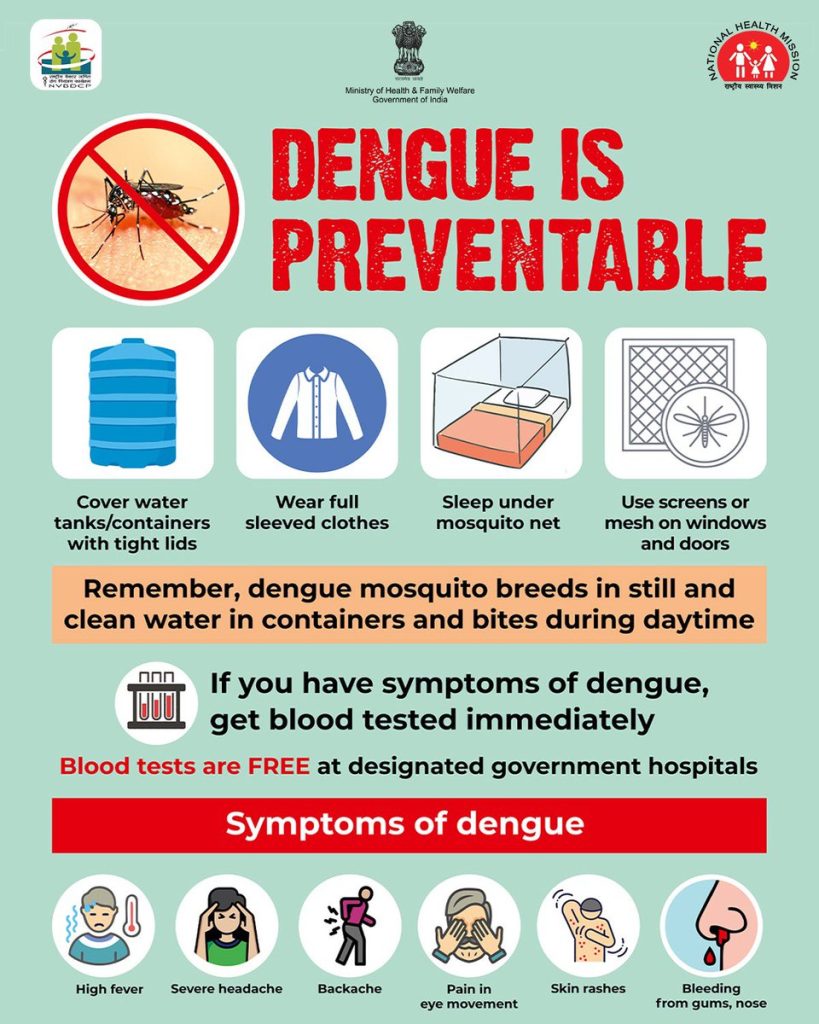
Dengue is a viral illness caused by the dengue virus, which is transmitted primarily through the
bites of infected female Aedes mosquitoes, particularly Aedes aegypti and Aedes albopictus.
Here’s a comprehensive guide on dengue, including its prevention, spread control, precautions,
and recurrence.
Causes of Dengue
- Virus Transmission: Dengue is caused by one of four related viruses (DENV-1, DENV-2,
DENV-3, or DENV-4). Infection occurs when a mosquito that has previously bitten an
infected person bites another person. - Mosquitoes: The primary vectors are Aedes mosquitoes, which are most active during
the daytime, especially early in the morning and late afternoon.
Prevention of Dengue - Mosquito Control:
o Eliminate Standing Water: Mosquitoes breed in stagnant water. Regularly empty
and clean containers such as buckets, flower pots, and old tires.
o Use Mosquito Repellents: Apply repellents containing DEET, picaridin, or oil of
lemon eucalyptus to exposed skin.
o Mosquito Nets: Use mosquito nets while sleeping, particularly in areas with high
dengue transmission.
o Mosquito Screens: Ensure windows and doors are fitted with screens to prevent
mosquitoes from entering indoors. - Personal Protection:
o Wear Protective Clothing: Long-sleeved shirts, long pants, and socks can help
reduce mosquito bites.
o Avoid Peak Mosquito Activity Times: Aedes mosquitoes are most active in the
early morning and late afternoon. - Community Efforts:
o Participate in Community Clean-Up Campaigns: Collaborate with local efforts to
reduce mosquito breeding sites.
o Educate the Community: Raise awareness about dengue prevention in your
community.
Measures to Stop the Spread - Early Detection and Treatment:
o Seek Medical Advice: If you suspect dengue, consult a healthcare provider
promptly. Early diagnosis can help manage the symptoms and avoid severe
complications. - Isolation:
o Avoid Mosquito Bites: Infected individuals should take steps to prevent
mosquito bites to avoid spreading the virus to others. - Monitoring and Surveillance:
o Public Health Measures: Governments and health organizations monitor dengue
cases and implement measures to control outbreaks, such as mosquito spraying
and public health advisories.
Precautions When Infected - Stay Hydrated: Dengue can cause high fever and dehydration. Drink plenty of fluids like
water, oral rehydration solutions, or clear soups. - Rest: Ensure you get plenty of rest to help your body recover.
- Avoid Certain Medications: Pain relievers like aspirin or nonsteroidal anti-inflammatory
drugs (NSAIDs) can worsen bleeding tendencies. Use acetaminophen (paracetamol)
instead for pain and fever, as recommended by your doctor. - Monitor Symptoms: Watch for signs of severe dengue, such as severe abdominal pain,
persistent vomiting, bleeding gums, or signs of shock (cold, clammy skin, rapid pulse).
Seek immediate medical attention if these symptoms occur.
Duration and Recurrence - Duration:
o Acute Phase: Dengue fever typically lasts 5 to 7 days, with symptoms like high
fever, headache, pain behind the eyes, muscle and joint pain, rash, and bleeding
tendencies.
o Recovery Phase: Recovery can take an additional week or so, with fatigue and
weakness potentially lingering longer. - Recurrence:
o Reinfection Risk: It’s possible to be infected with a different dengue virus
serotype after recovering from an initial infection. This can lead to more severe
forms of the disease, such as dengue hemorrhagic fever or dengue shock
syndrome. However, having dengue once does not guarantee lifelong immunity
against other serotypes.
In summary, dengue prevention revolves around mosquito control and personal protection,
while management of the illness focuses on hydration, rest, and avoiding certain medications.
The duration of the illness is generally a couple of weeks, and reinfection with a different virus
serotype is possible.



